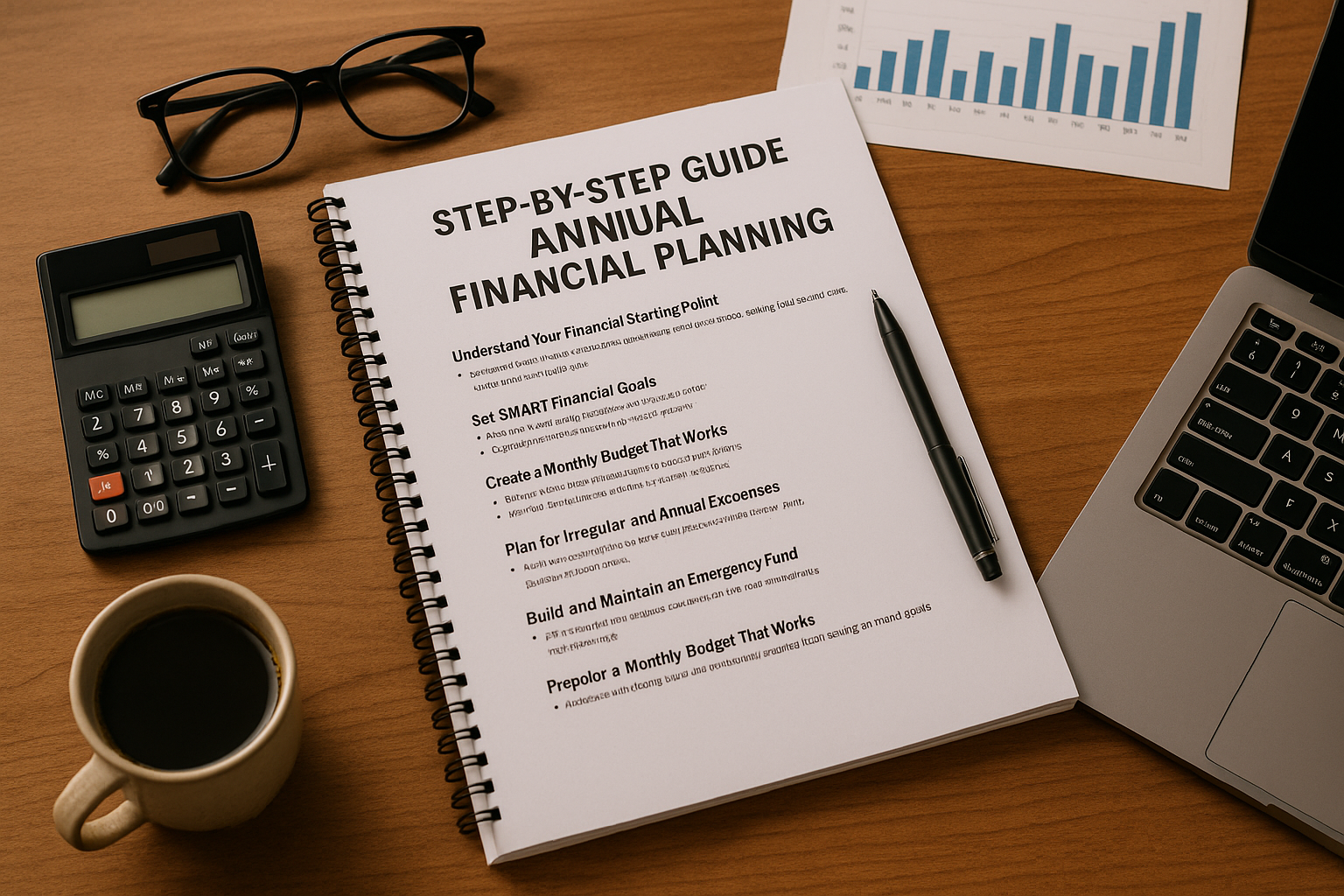Financial planning is not just about budgeting or cutting costs. It’s about creating a clear roadmap for your money that aligns with your personal goals and lifestyle. An annual financial plan provides a big-picture view of your finances, helping you make informed decisions and adapt to changes throughout the year.
Whether you’re just getting started or looking to refine your approach, this guide walks you through every step to build a solid financial plan for the year ahead.
Understand Your Financial Starting Point
Before making any plans, it’s essential to take a clear look at your current financial situation. This includes:
- Income: Total all sources of regular income, such as salary, freelance work, side hustles, dividends, or rental income.
- Expenses: Track your monthly spending — fixed costs like rent/mortgage, utilities, transportation, and variable expenses like dining out or entertainment.
- Assets: Include everything you own that has value — savings, investments, real estate, vehicles, etc.
- Liabilities: List all debts — credit card balances, student loans, car loans, mortgage, etc.
Use a spreadsheet or personal finance app to collect this data. This snapshot will serve as your foundation for goal-setting and budgeting.
Set SMART Financial Goals
Goals give your plan purpose. But not just any goals — use the SMART framework:
- Specific: Clearly define the goal. (e.g., Save for a $5,000 vacation)
- Measurable: Track progress along the way.
- Achievable: Set realistic goals based on your income and expenses.
- Relevant: Align with your personal values and long-term plans.
- Time-bound: Attach a deadline (e.g., 12 months, 6 months).
Common financial goals include:
- Paying off credit card debt
- Building an emergency fund
- Saving for a home down payment
- Increasing retirement contributions
- Investing a specific amount
Create a Monthly Budget That Works
A budget is the engine of your financial plan. It ensures your money flows in the right direction. Start by using the 50/30/20 rule as a guideline:
- 50% on needs: housing, utilities, groceries, transportation
- 30% on wants: entertainment, shopping, dining out
- 20% on savings and debt repayment
Customize your budget to suit your lifestyle and financial goals. Consider using tools like YNAB (You Need a Budget), Mint, or spreadsheets to manage and track your budget each month.
Plan for Irregular and Annual Expenses
Annual planning requires looking beyond your monthly obligations. Think about:
- Holidays and gifts
- Insurance premiums
- School fees or tuition
- Property taxes
- Vacation costs
- Car maintenance or registration
Estimate these amounts and divide them into monthly savings goals. For example, if you plan to spend $1,200 on vacation this year, set aside $100/month.
Build and Maintain an Emergency Fund
An emergency fund protects your finances against unexpected costs like job loss, car repairs, or medical bills. Aim to save:
- 3 to 6 months of essential living expenses (rent, food, bills)
Start small if needed — even saving $500 to $1,000 can provide peace of mind. Use a high-yield savings account for this fund to keep it accessible and growing.
Review and Adjust Your Debt Strategy
Debt can hinder your financial progress, but with a plan, you can take control.
Two popular methods to reduce debt are:
- Snowball Method: Pay off the smallest debts first for quick wins
- Avalanche Method: Pay off debts with the highest interest rates first to save more money
Review your interest rates, minimum payments, and payoff timeline. Allocate extra funds toward your strategy every month.
Plan Your Investments
If you’ve already built an emergency fund and paid off high-interest debt, it’s time to grow your money through investments. Start by reviewing:
- Retirement Accounts (401k, IRA, Roth IRA)
- Brokerage Accounts
- Robo-Advisors (e.g., Betterment, Wealthfront)
- Stock Market or Index Funds
- Real Estate Investments
Make sure your portfolio matches your risk tolerance and financial timeline. Rebalance your portfolio at least once a year.
Track Your Net Worth
Your net worth is the total of your assets minus your liabilities. It gives you a simple number to monitor your financial progress over time.
Check it every quarter or bi-annually. Watching your net worth grow (even slowly) can be a great motivator.
Plan for Taxes
Taxes can eat up a large part of your income if not managed properly. Each year, review:
- Your filing status and if any changes apply
- Tax-deductible expenses you might miss (e.g., charitable donations, mortgage interest, education costs)
- Retirement contributions that reduce taxable income
- Any side income and how it should be reported
Use online tax calculators, or consider working with a professional if your situation is complex.
Prepare for Major Life Events
If you expect big changes this year, plan ahead financially. Examples:
- Getting married or divorced
- Having a baby
- Buying a house
- Changing careers or retiring
Major life events can reshape your income, expenses, and priorities. Adjust your financial plan early to stay prepared.
Set Monthly and Quarterly Checkpoints
Your financial plan isn’t “set and forget.” Schedule time each:
- Month: Review your budget, spending, and goals
- Quarter: Reassess your priorities, debt repayment, investment contributions
- Year-end: Evaluate the entire plan — what worked, what didn’t, and what needs to change
Consistency is more important than perfection. Even if you get off track, regular reviews help you correct the course quickly.
Celebrate Progress, No Matter the Size
Reaching financial goals takes time. Celebrate milestones — even small ones like saving your first $500 or paying off a single credit card.
This helps reinforce good habits and keeps you motivated for long-term success.
Planning Ahead Builds Freedom
Annual financial planning isn’t about restriction — it’s about freedom. When you know where your money is going, you gain clarity, confidence, and control over your future. You reduce stress, avoid surprises, and can pursue your goals with intention.
Start where you are, plan wisely, and stay consistent. A financially healthy year is built one smart step at a time.

